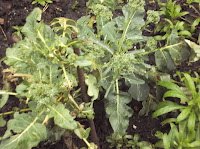


 The garden hasn’t done badly this year, though due to a combination of family stuff, very high pollen levels and a bad attack of harvest mites (horrible biting insects which are common in old gardens, to which I am very sensitive), all of which meant that I didn’t go out as much as I would have liked, I’ve been neglecting it a bit until this week. The gooseberry crop was good for a first full year, and the tomatoes have been very prolific.
The garden hasn’t done badly this year, though due to a combination of family stuff, very high pollen levels and a bad attack of harvest mites (horrible biting insects which are common in old gardens, to which I am very sensitive), all of which meant that I didn’t go out as much as I would have liked, I’ve been neglecting it a bit until this week. The gooseberry crop was good for a first full year, and the tomatoes have been very prolific.
The irises had their glorious moment.
The lavenders did well, the pond was full of frogs and waterlilies, and the moondiasies lit up the woodland corner.
Because of taking my grand-daughter to the gym, I extended my territory walk along a new road out beside the water works and the Army Depot, where there were some lovely lush roadside verges. There were vetches of all sorts and clovers and dead nettles, but the most exciting new flowers on my list were these beauties, coming up like mushrooms among the corporate groundcover of a car park. A friend on facebook identified them for me as broad-leaved helleborines. There were lots of butterflies too, thanks to the good weather, meadow browns, small coppers, commas, tortoiseshells, peacocks and a lot of whites.
The birds seem to have had a good year too, especially the sparrows and starlings. There were more swifts than I ever remember here, and the swallows and house-martins have reared good broods in spite of the gull colony. A mallard has raised a brood too, five out of ten ducklings, which is the best I remember in twenty years, and there are juvenile robins, dunnocks and blue tits hanging about the garden. All the birds are back in the gardens now, after the seeding grasses, and I’ve started filling up the feeders. But this means that other things are back too – I’ve heard an owl at nights and seen a kestrel, and I am reminded that it’s only at this time of year I see the sparrowhawk in the village. This applies to the river too, which must be full of fish now, because the cormorants are back, and a seal was sighted under the bridge.
It looks as though we are seeing the last of the summer. The children are back at school, and I am getting back into the swing of the poetry, the translations, the philosophy, and a couple of editing projects I am cooking. It’s been good.






























